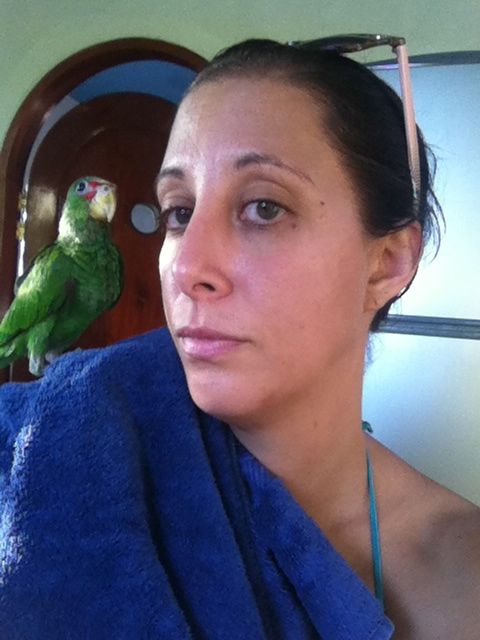 I’m making coffee in my outdoor kitchen when I see the green. I turn and he’s sitting on the patio rail. I freeze. I’ve seen flycatchers, doves, cuckoos. But not parrots. Parrots belong in the jungle.
I’m making coffee in my outdoor kitchen when I see the green. I turn and he’s sitting on the patio rail. I freeze. I’ve seen flycatchers, doves, cuckoos. But not parrots. Parrots belong in the jungle.
I stare at him and wonder if I have time to get my camera. He’s beautiful, red and yellow around the eyes, a yellow beak. He stares back. Then he jumps to the floor. “Crock, crock.” I take a step forward. He flys at my face.
I run to the other side of the kitchen. He lands, and waddles toward me marching with intent. He is five inches tall at most. “Crock crock.” He goes airborne again and chases me into my apartment.
Now we are both inside, the parrot waddling furiously, me trying to find my phone to take a video while simultaneously deciding whether the bird is rabid. I find the phone and press record. He chases me back out of the apartment.
He squats on the kitchen floor looking perturbed. I turn off the recorder and we stare at each other. He could be a pet. I put on an oven mitt and place my protected hand on the floor. He waddles over and steps on. “Crock crock.” I lift him and he begins to climb.
I lose my nerve, slide the mitt and attached bird on to the kitchen table, and run down to the yard to find my landlord, Armando, who has been both a cattle rancher and a free-diving lobster fisherman. He can answer nature-related questions: how to assess a green mango for ripeness, revive a stunned woodpecker, dispose of a dead bat.
I use my Spanish. “A parrot arrive in my kitchen. I believe it is pet. What to do? No is dangerous, no?”
Armando laughs. Armando always laughs: shirtless, curled silver moustache, mischievous eyes. The mango will be ready in two days. The woodpecker should be put in a basket until it comes to so the cats won’t get it. The bat can be buried in the garden if I insist on being overly sentimental. I follow Armando back up the stairs to my kitchen.
The parrot is still sitting on the table. “Crock crock.” Armando gently grabs the bird around the wings and places him on his finger. “Crock crock crock crock crock,” says the bird. “Tiene hambre,” says Armando. He’s hungry. Armando asks if I have any fresh masa.
I look in my refrigerator. I have mangos and stale tortillas. Armando says the tortillas are too sharp. I can try the mango but he will find some better food.
He indicates that I should hold out my finger and the parrot comes to me without objection but shifts quickly from my finger to my thumb, which seems a more comfortable width for his dinosaur feet. Armando leaves. “Crock crock,” says the bird. “Crock crock,” I say.
I try to pet the bird’s back, like I would a cat. He flaps irritably. Lesson 1: the parrot is not a cat. I walk to the counter and one-handed, cut a slice of mango. I hold it near the parrot’s beak. “Crock crock.” Lesson 2: the parrot does not want mango.
Armando returns with his wife Sonja and a bowl of mixed flour and water. Sonja had seen the bird that morning—she thinks it came from the house behind ours. Definitely a pet.
Armando hands me a spoonful of white goo and the parrot begins to eat, jabbing at the spoon, sticking out his little bean tongue to lap up the sludge. Lesson 3: The parrot likes flour and water. But Sonja suggests we should still get some fresh masa since the current mixture is basically glue. We enlist my neighbor to run the errand.
Sonja and Armando leave and we are alone. The parrot pecks at the spoon and digs his talons into my skin, gripping so he doesn’t fall. It is sweet and vulnerable but also painful. I decide: I will call you Stabby.
My neighbor drops off the masa and a cup of green smoothie and I try feeding these to Stabby, now using just my fingers. He licks eagerly, calming down, emitting quieter noises between each bite. In this moment of sweetness I realize holy crap, this is incredible. I take a selfie and post it to Facebook.
When Stabby seems to be done eating, I start calling friends through FaceTime. I reach Joanna. Instead of saying hi I simply waggle my eyebrows and lift Stabby into the frame of view. Joanna is delighted. I lift Stabby up and down at diagonals so he looks like he’s riding an escalator across the FaceTime screen.
It’s Joanna who suggests I add “Don” in front of “Stabby,” which in Mexico is a respectful title approximately meaning “Mister.” With that, it is decided that Don Stabby is male and for fancy occasions, shall be called Don Stabuloso.
After I hang up, I try out Don Stabuloso in various locations in the apartment. I place him on the dining room table where he waddles uncomfortably. “Crock crock.” I move him onto the backrest of a wooden folding chair that he can grip with his feet. He looks much happier and expresses his appreciation by pooping. I decide he should not sit on anything upholstered.
I realize I need a shower. And coffee. And food. All of which I’ve forgotten since Don Stabuloso arrived. I place him on the tile floor which seems safe, and take a shower. When I get out I find him at the bottom of the folding chair, his feet curled around the rung that connects the chair’s legs. He has pooped again.
I get dressed, place Don Stabuloso on my thumb and return to the kitchen, where I find that the administrator for our compound, Cauich, has arrived with a small red wire bird wage and a pile of newspaper. Cauich says that if I don’t want the bird, he will take him. He has many animals, including two birds and two dogs. I say I think we should try to find the parrot’s owner. As soon as I say it I feel incredibly sad.
I also feel sad about the cage. But I understand that if I keep Don Stabby he will continue to need a place to poop that is not my floor. I put Don Stabby in the cage but leave the door open. He sits where I’ve placed him, his tail feathers hanging out.
Cauich says he thinks the bird belongs not to the backyard neighbors but to the people across the street. We decide that if we can’t find the owner, Don Stabby will stay with me until I leave Mexico and then Cauich will take him.
We have a plan. In the cage, Don Stabby sits in silence. He looks very small.
On Facebook there are many comments, expressing love for Don Stabby and encouraging me to keep him. There is one that disturbs me: “Parrots form an incredible attachment to humans and if that’s you, he will be devastated when you leave.”
I go on the Internet and learn more about parrots. They mate for life. In captivity they often transfer their mate love to their keepers. Don Stabby is most likely a Yucatan Parrot. Yucatan Parrots are supposed to be wild birds and as such cannot be brought to the United States according to Mexican law and the Convention on International Trade in Endangered Species of Wild Fauna and Flora. I realize it is legally impossible for my relationship with Don Stabby to be anything but temporary.
I try to take Don Stabby out of his cage but he flaps irritably so I let him be. I refresh his water bowl and put a wooden spoon through the bars so he’ll have a comfortable place to perch. I watch him fluff and settle, showing off the blue tips of his wings. I notice that under the wings he is sort of scrappy, downy white fluff on pink skin. I wonder if this is normal, or if he’s been neglected or is sick.
I realize I need to go grocery shopping. I feel guilty about leaving him alone. But I realize if Don Stabby is going to stay here, there will be other times I need to go grocery shopping. And go to work. And go to sleep.
I decide he should stay inside the apartment. I place the cage on the dining room table, near the window. The midday sun is burning through the glass. Don Stabby stares into it, seeing but not seeing. I move the cage so he can have a bit of shade if he wants. I leave the cage door open so he can go exploring.
When I come back Don Stabby is still in the cage, perched on the handle of the wooden spoon. He doesn’t acknowledge me. Perhaps he has been lonely. I take the cage outside to the kitchen table so we can be together while I cook. While I chop onions and garlic, he is quiet. It feels too quiet. I stick in my hand, remove him from the cage and place him on my shoulder. “Crock,” says Don Stabby into my ear. I decide this is an improvement.
Shoulder-riding takes some adjustment on both of our parts. When I bend over, Don Stabby climbs onto my back which complicates straightening up. I have to rest my head on the kitchen table so he can climb off and we start again. I drape my shoulders with a towel to give him something better to grip, and soon Don Stabby moves naturally with my body, climbing to my shoulder blades when I bend, climbing back to rest by my ear when I straighten.
While I wait for the food to cook, I sit at the kitchen table, drink a beer and we talk. “Crock,” he says. “Crock,” I say. “Crock,” he says. “Crock,” I say. I decide he may be hungry again. I take the masa out of the refrigerator and let him nibble it off my fingers. “Crock.” His throaty noises sound happy, tiny coos.
I pick up my phone and take more selfies. Don Stabby looking at the camera. Don Stabby talking in my ear. Don Stabuloso chewing on my hair. The pictures are adorable. I open WhatsApp to send one to a friend.
And then in a flash of green, he has disappeared over the patio rail, heading for the street.
I race to find my keys then run down the kitchen steps and through the compound garden. I unlock the door to the gate and step out on the street. The sun is starting to set. Grackles scream in the trees and flycatchers twitter on the power lines. But Don Stabby is gone.
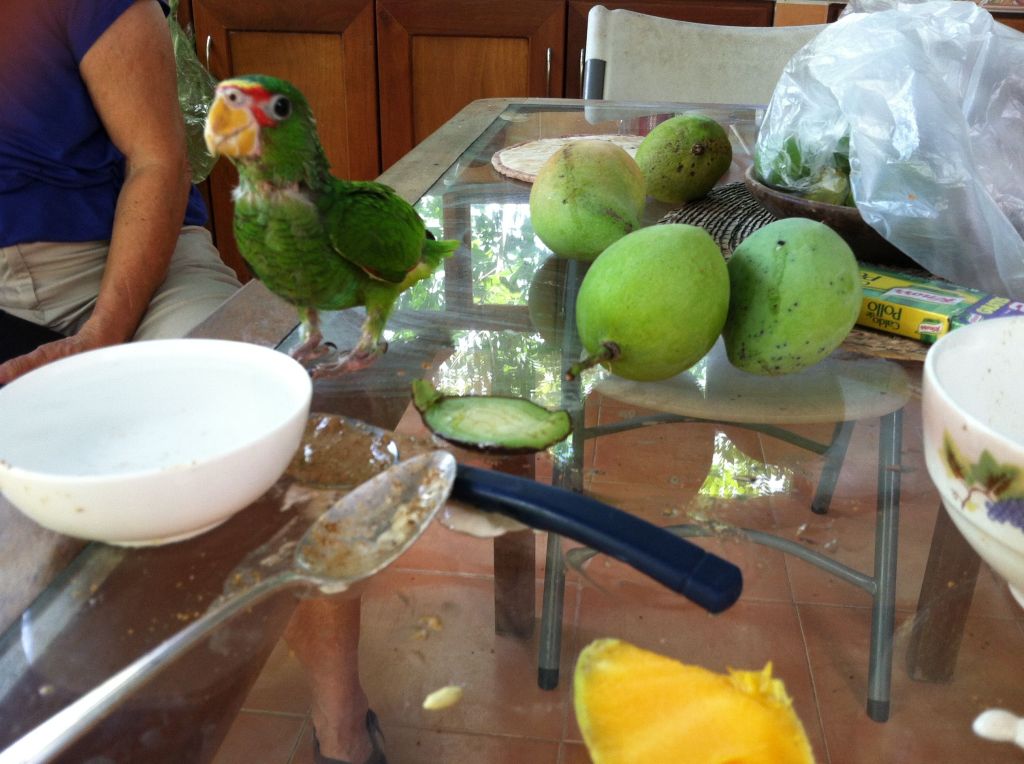
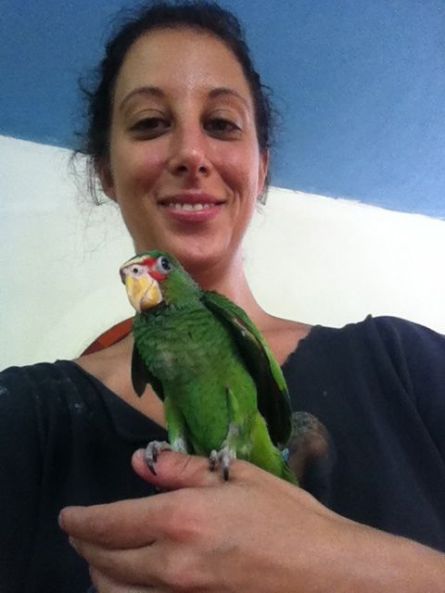
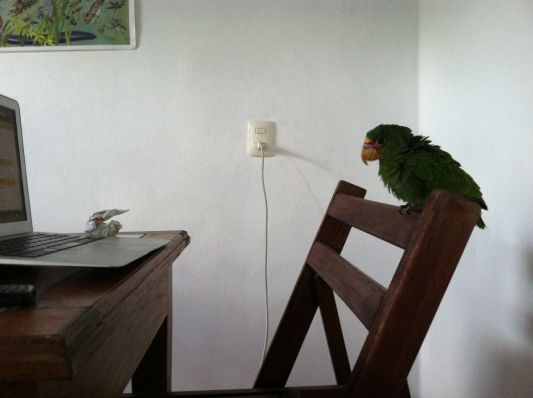
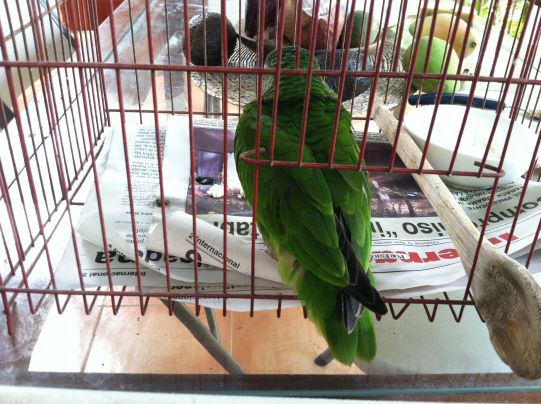
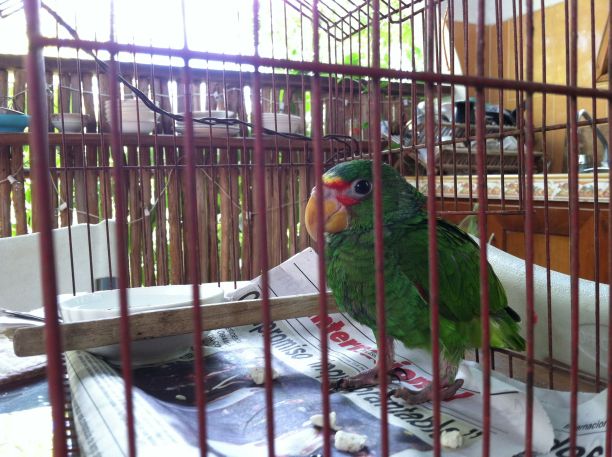
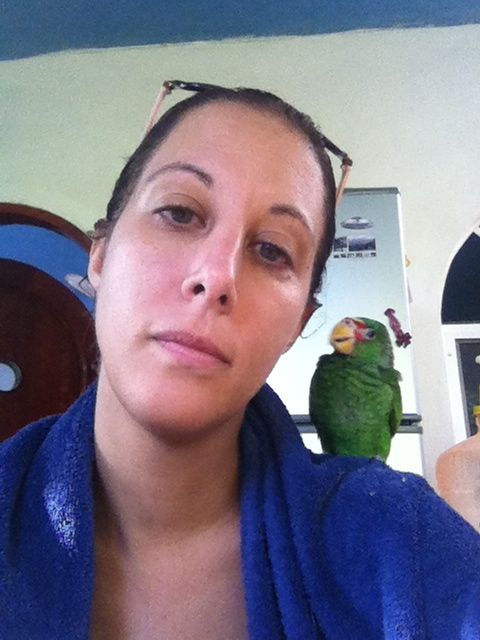

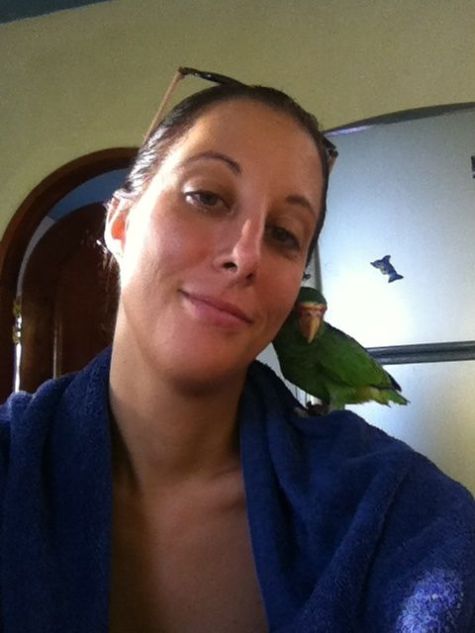
Now I am incredibly sad that Don Stabuloso has moved on!! He sounds more like Don Juan, staying just long enough to make you fall in love with him, and then he leaves you!! 🙂
LikeLiked by 1 person
So am I! A week later it’s possible I still have a bowl of fresh water on the table and keep scanning the skies. xo
LikeLike
I love your writing! It really makes me smile when your posts drop in. Hope he found his owners, sure he did, but that he remembers his lovely holiday x
LikeLiked by 1 person
Thank you so much! I love your writing as well. Eloquent, thoughtful and I think you probably get the word brave a lot, but yeah, it’s brave. Cheers to you from the Yucatan!
LikeLiked by 1 person